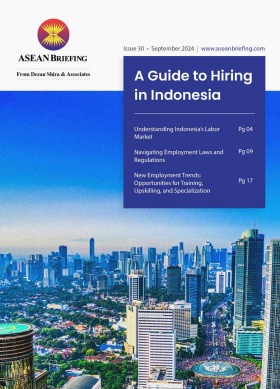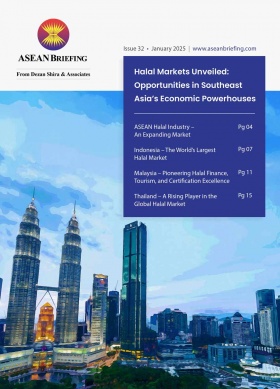Why Norwegian Investors Should Look to Indonesia
Indonesia holds a prominent position as Southeast Asia’s largest economy, underpinned by a large domestic market, political stability, and consistent economic growth. In 2024, Indonesia’s GDP grew by 5.03 percent, slightly lower than the 5.05 percent recorded in 2023. This reflects both resilience and moderation, falling just below the pre-pandemic 10-year average of 5.07 percent. The economy reached IDR22.139 trillion (US$ 1.4 trillion) in nominal terms, with per capita GDP rising to IDR78.6 million (US$ 4,960).
While private consumption grew by 4.98 percent, the middle class — defined by the World Bank as individuals spending IDR2–9.9 million (US$130–640) per month — contracted from 57.33 million in 2019 to 47.85 million in 2024, now representing just 17.3 percent of the population.
Norway’s global competitiveness in renewable energy, maritime technology, and sustainable development makes it a natural partner for Indonesia’s national development ambitions.
Although bilateral ties exist, the full investment potential between the two nations remains largely untapped.
Indonesia’s economic environment: A platform for growth
Indonesia benefits from sound macroeconomic fundamentals and strategic positioning. Despite global headwinds, investment activity surged in 2024. Total investment reached IDR1,714.2 trillion (US$ 110 billion), up 20.8 percent year-on-year and generating 2.4 million jobs. Foreign direct investment accounted for 50.8 percent of this, reaching US$ 53 billion in H1 2024.
Key FDI sectors include basic metals (US$ 7.8 billion), especially EV battery production. Leading investors include Singapore (US$ 8.8 billion), China (US$ 3.9 billion), and Hong Kong (US$ 3.8 billion).
Indonesia’s central location within ASEAN continues to offer an advantage for regional access, while reforms such as the Omnibus Law and the OSS system have simplified entry procedures for foreign investors.
Renewable energy: Powering a sustainable future together
Norway generates approximately 98 percent of its electricity from renewable sources, predominantly hydropower. The country is also a leader in offshore wind and is developing some of the world’s first large-scale floating wind farms. Norwegian firms can contribute not only capital but also deep technical expertise in grid integration, offshore wind, and energy storage.
There is room for collaboration in early-stage development, joint pilot projects, and policy advisory support.
Maritime and fisheries: Anchoring blue economy partnerships
Norway is home to one of the most advanced maritime clusters in the world and is the second-largest exporter of fish globally. It also has cutting-edge capabilities in autonomous vessels, marine safety technologies, and sustainable aquaculture.
Norway’s leadership in maritime cluster development — including automation, ship design, and aquaculture — can directly support Indonesia’s maritime ambitions. Joint ventures in vessel retrofitting, marine safety, and cold chain logistics are promising.
Oil and gas: Managing the transition with Norwegian know-how
Norway is the largest oil and gas producer in Western Europe, with advanced offshore exploration, drilling, and carbon capture capabilities. In 2024, Norway’s total petroleum production reached 241.2 million standard cubic meters of oil equivalents (Sm³ o.e.), the highest level since 2009.
Daily oil production averaged approximately 2 million barrels in December 2024, while gas exports hit a record 124 billion cubic meters, meeting around 30 percent of Europe’s gas demand. Norway is also at the forefront of decarbonizing the sector through electrification and emissions monitoring.
The Northern Lights project, launched in 2024, provides commercial CO₂ transport and storage services and aims to inject up to 5 million tons of CO₂ annually by 2028. Meanwhile, the Sleipner field has been storing about 1 million tons of CO₂ annually since 1996, proving the long-term viability of offshore carbon storage.
Norway’s experience in offshore operations and environmental technologies is highly relevant as Indonesia pursues efficient and low-impact fossil fuel development. Collaboration in floating production, subsea systems, and carbon capture could be pivotal. The country is also at the forefront of decarbonizing the sector through electrification and emissions monitoring.
Digital transformation: Addressing Indonesia’s tech leap
Indonesia had 185.3 million internet users in 2024, with an internet penetration rate of 66.5 percent, and 353.3 million mobile connections, 126.8 percent of its total population. The digital economy reached US$ 90 billion in 2024 and is projected to grow to US$ 120 billion by 2025.
E-commerce transactions totaled US$ 51.9 billion in 2024, while fintech services are expected to reach US$ 20.93 billion by 2025. Norway has a vibrant tech sector with strengths in cybersecurity, e-governance, and digital public infrastructure. The country ranks consistently high on digital competitiveness and innovation indices.
Norwegian companies can provide solutions in digital ID, cybersecurity, data management, and digital inclusion, and can tap into Indonesia’s rapidly growing digital economy, which is projected to reach US$ 120 billion by 2025.
Emerging opportunities in green infrastructure and health
Norway has long experience in sustainable urban development, water purification systems, and circular economy practices. Norwegian engineering firms are global leaders in low-carbon infrastructure and climate adaptation solutions.
In healthcare, Indonesia had 0.7 physicians per 1,000 people as of 2022. Healthcare spending stood at 3.1 percent of GDP in 2024, with continued underinvestment in medical infrastructure. Major imports include diagnostic and imaging equipment, pharmaceuticals, and surgical instruments. Telemedicine, initially expanded during COVID-19, remains a fast-growing sector supported by regulatory reforms.
Human capital development and education partnerships
In 2024, Norway maintained its position among the top OECD countries for education spending per capita, investing approximately US$17,779 per full-time equivalent student in public primary institutions, significantly above the OECD average of US$11,914. The country boasts a robust educational infrastructure, with 29.3 percent of upper secondary students enrolled in vocational programs and tertiary education attainment rates of 68 percent for women and 47 percent for men. Norway is globally recognized for excellence in STEM education, digital learning, and applied research, positioning its institutions as leaders in modern education delivery.
Indonesia presents high-potential opportunities in both vocational and higher education. With over 5 million students enrolled in vocational high schools (SMK) as of the 2022–2023 academic year, and more than 4,400 higher education institutions nationwide, the scale is significant. As of 2024, the Gross Enrollment Ratio (GER) in tertiary education reached 35.23 percent for females and 28.89 percent for males. While participation is expanding, the country faces persistent challenges, including underfunding, skill mismatches, and limited research output.
This creates meaningful openings for Norwegian educational institutions and edtech companies to invest in curriculum development, digital skills platforms, and institutional partnerships. Joint programs in vocational training, STEM education, faculty exchange, and digital learning technologies can help Indonesia align education outcomes with labor market demands. For Norwegian investors, this is both a strategic market entry and an opportunity to support Indonesia’s broader digital and green economy transition.
Choosing the right market entry strategy
Norwegian investors can enter the Indonesian market through direct investment (via PT PMA), joint ventures, or public-private partnerships. While direct ownership offers more control, joint ventures often yield quicker results and better regulatory acceptance.
Legal guidance is crucial when navigating sector-specific restrictions or localization rules. Building strong local partnerships and understanding cultural nuances — such as relationship-first negotiations and deference to seniority — will also enhance success.
Learning from success: Nordic business stories
Jotun, a Norwegian paint company, has operated in Indonesia for decades, adapting its products to tropical conditions and investing in local manufacturing. DNV, a major player in energy and maritime certification, has successfully built partnerships by aligning with Indonesian regulatory priorities. IKEA, another well-known Nordic brand, has expanded steadily in Indonesia, tailoring its retail strategy to local consumer behavior and supply chain infrastructure.
These examples show the importance of local adaptation, long-term vision, and regulatory compliance for Nordic firms entering the Indonesian market
About Us
ASEAN Briefing is one of five regional publications under the Asia Briefing brand. It is supported by Dezan Shira & Associates, a pan-Asia, multi-disciplinary professional services firm that assists foreign investors throughout Asia, including through offices in Jakarta, Indonesia; Singapore; Hanoi, Ho Chi Minh City, and Da Nang in Vietnam; besides our practices in China, Hong Kong SAR, India, Italy, Germany, and USA. We also have partner firms in Malaysia, Bangladesh, the Philippines, Thailand, and Australia.
Please contact us at asean@dezshira.com or visit our website at www.dezshira.com and for a complimentary subscription to ASEAN Briefing’s content products, please click here.








